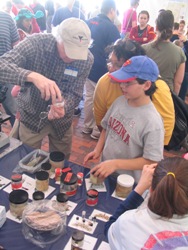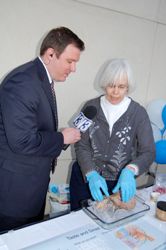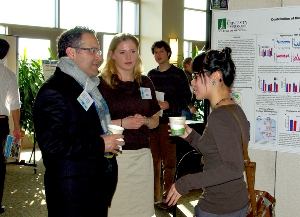Chapter Showcase
| Tucson Chapter Brain Awareness Outreach |
| |
|
The Tucson chapter Brain Awareness activities were a
great success, with more than 600 people visiting their "Brain
Works" exhibit to explore the wonders of the brain.
|
|
|
|

|
|
|
|
A brain zoo featuring over 20 brains
included a real human brain and half of a beluga whale brain.
|
|
|
|

|
|
|
Taking a look at Golgi
stains of
cortical neurons. |
|
|
|

|
|
|
|
KOLD Channel 13, a local
TV station featured the Tucson chapter outreach.
|
|
|
|

|
|
|
|
The eat-a-brain station had participants memorize the
placement of five functional tags to taste their favorite part of the
brain.
|
|
|
| Vermont Chapter 5th Annual Neuroscience
Research Forum |
|
|
|

|
| |
|
The Vermont chapter forum drew more than 120
attendees for two days of neuroscience outreach, education, and
discussion.
|
|
|
|

|
|
|
|
Grass Traveling Lecturer, Dr.
Quinones-Hinojosa speaks to the chapter about his brain cancer research
and patient treatment.
|
|
|
|

|
| |
|
A panel engages the audience with discussions of
public advocacy and communication in science.
|
|
|
|

|
|
|
|
Dr. Alfredo Quinones-Hinojosa interacts with
student members and visits poster presentations.
|
|
|
Learn about the activities of featured SfN chapters from around
the world and get ideas for your own chapter. To highlight your
chapter's activities, e-mail chapters@sfn.org.
Tucson Chapter
Brain Awareness Week 2010 Outreach
The Tucson chapter
kicked Brain Awareness
Week 2010 outreach into high gear at the annual University of
Arizona (UA) Book Festival, an event that attracts more than 50,000
people. The chapter hosted a science pavilion, along with the Bio5 Institute,
where attendees could learn about the brain through a “Brain Works”
exhibit.
The “Brain Works” exhibit offered the community reading materials
from the Dana Foundation and the Society for Neuroscience, as well as a
presentation showcasing the fascinating brain research from 40 UA
campus laboratories. The exhibit also allowed the public to participate
in a variety of activities specifically designed to teach and generate
interest in neuroscience. Over 20 chapter
volunteers managed the exhibit and the chapter estimates that
more than 600 people stopped by in the course of two days.
Below are examples of activities the Tucson chapter organized:
Brain Zoo
A brain zoo showcased 20 preserved real brains
including a human brain, a human spinal cord, and a whale brain. The
station also included a microscope that focused samples of beautiful
Golgi stains of cortical neurons.
Taste vs. Smell Jelly
Bean Demonstration
Blind folded participants, mostly 10 years old or
younger, volunteered to taste jelly beans and guess theflavors when
their noses were pinched and when they were not. Flavors, such as
cinnamon and chocolate, require smell to be able to identify them, while
other flavors, such as lemon, can be differentiated by tongue receptors
only.
Kids Corner
Young aspiring neuroscientists were invited to
color the various sections of the brain and then to recite the names of
the parts out loud. The Kids Corner also allowed youngsters to create
neurons out of colorful pipe cleaners that were added to a neural
network wall.
Eat-a-Brain
The most daring visitors memorized the placement of
five functional tags (vision, audition, touch, movement, and planning)
on a Jell-O brain, and, if they could remember their placement
successfully, were then allowed to taste their favorite brain area.
Prism Glasses and
Visual Adaptation
This station gave visistors an opportunity to see
how the brain adapts to 30 degree shifts in the visual world with prism
glasses. Classical visual illusions such as the scintillating grid, Mach
bands, Rubin vase, and peripheral drift were also included.
Somatosensory
This station displayed pictures of the homunculus
and a two-point discrimination threshold demonstration.
The Tucson chapter’s outreach was featured on local TV stations
and in the University of Arizona, newsletter, UANews.
For information about the Tucson chapter and
their 2010 BAW outreach visit the chapter’s Web site.
Vermont Chapter
5th Annual Neuroscience Research Forum
The 5th Annual Neuroscience
Research Forum hosted by the Vermont chapter and
The University of Vermont (UVM) Neuroscience Graduate Program, was a
resounding success. Dr. Alfredo Quinones-Hinojosa, the chapter’s Grass
Traveling Scientist, kicked off the meeting with a keynote
talk on “Brain Cancer: Current Paradigms.” This remarkable presentation
covered the multidisciplinary approaches he uses in treating brain
cancer patients and his basic research program on stem cells isolated
from brain tumors. Dr. Quinones-Hinojosa, who rose from humble origins
as a migrant farm worker in California to become a world-renowned
neurosurgeon and physician scientist at Johns Hopkins University,
inspired the entire audience by his passion for science and medicine.
The presentation was supported by the SfN
Grass Traveling Scientist Program, which allows chapters to engage
in and foster neuroscience education at the local level.
During the second day of the event, attendees viewed 48 posters, of
which 22 were presented by graduate students and 2 by undergraduates.
Reviewers were assigned to each of the student posters and presentations
were evaluated for $50 cash awards. In all, four graduate students and
both undergraduates received awards. The forum continued with a session
on “New Perspectives in Neuroscience” and three short talks highlighting
new areas of collaboration possible within the university community.
The forum was also supported by the SfN Chapter Grant mechanism, which
promotes novel initiatives linked to neuroscience literacy, education,
and training.
The second day also included a lively advocacy discussion, “Public
Advocacy and Communication in Science,” with guests Melody
Burkins, Senior Director for Research and Strategic Initiatives at UVM
and former scientific liaison for Sen. Patrick Leahy; Kelly VanKoughnet,
VP, Corporate Affairs, Council of Canadian Academies, who has a PhD in
Neurobiology from Harvard Medical School; and Jennifer Nachbur, Senior
Public Relations Specialist for the UVM College of Medicine.
Chapters are critical to the success of SfN advocacy and animal
research activities. One way to help your chapter enhance its advocacy
efforts is to use a grant to host a laboratory tour and invite local
policymakers to see the benefits of research first hand. To learn more
about exciting advocacy and animal research activities, contact advocacy@sfn.org.